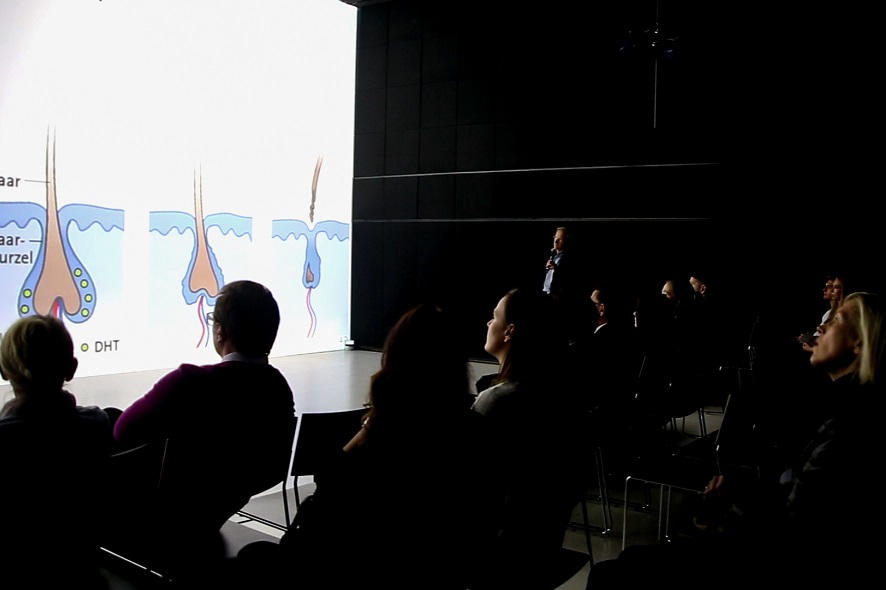There are many reasons for hair loss—chemotherapy, illnesses, or just normal aging. On the other hand, reactions to it are often similar: shock, shame and distress are common. But that doesn’t have to be, according to hairdresser Peter Fuchs, gynecologist Peter Oppelt and plastic surgeon Matthias Koller.
The three specialists work closely together to treat the problem of hair loss. Therapies involving plasma derived from the patient’s own blood, hair transplants and wigs are some of the methods they use to help sufferers … and to break widespread taboos.
In this interview, the three experts explain why delivering attentive care to hair loss patients is so important, what the PRP treatment entails, and why hair loss is a taboo topic for so many people.
The three of you are specialists in very different fields. How did you start working together?
Peter Fuchs: It actually began about three years ago. Chemo patients needed help, and their physicians came to me as a hairdresser. I had gotten a lot of experience with wigs, above all in England and the USA, where it’s totally normal to wear a wig. Finally, we conducted an inquiry here about what’s important for chemo patients. And in this work, we discovered that there are actually many different problems that lead to hair loss—alopecia, other illness like rheumatism, and even hereditary hair loss.
Peter Oppelt and I started working together on the chemo problem. Then I got to know Matthias Koller, and the three of us developed the idea further.
Peter Oppelt: We had a problem providing appropriate care to patients who had lost their hair, eyelashes and eyebrows due to chemotherapy. The idea was not to simply sell wigs but rather to offer an entire concept. We don’t get started only after the hair has fallen out; we begin even before the chemotherapy does. We discuss how the patient might look after the treatments, and many patients even start wearing a wig immediately without waiting for their hair to fall out—and thus omit the transition phase.

Credit: Vanessa Graf
Dr. Koller, how does your specialized knowledge come into play in this talk?
Matthias Koller: My part is discussing the platelet rich plasma [PRP] treatment I perform for my patients. That’s also my contribution to our collaborative arrangement—performing PRP treatments to combat hair loss. Peter Fuchs is the key man in this collaboration; he’s the one who had the idea and who has the most experience working with hair.
What happens during the PRP treatment?
Matthias Koller: This therapy involves plasma derived from the patient’s own blood. First we draw blood and centrifuge it to separate the plasma, which is then injected into the patient’s scalp. The plasma contains growth factors that stimulate cell growth, and the hair follicles are reactivated.
Peter Fuchs: About a year ago, in conjunction with our collaboration, we got to know a young woman—she’s now 25—who had come to me about a wig. She had a major problem with hair growth—sparse hair, very little hair growth overall, and no one knew what the cause of this could be. Within the last eight months, we’ve succeeded in getting her to the point at which she can probably live without a wig now. With PRP treatments, we’ve restored her hair.
Matthias Koller: Three women who’ve suffered from this condition will be in attendance at our presentation in Deep Space, so audience members will be able to meet real people living with this problem. First and foremost, the point of this is breaking a taboo, since it is simply the case that having no hair is still a taboo subject.

Credit: Vanessa Graf
Is that generally so or only among younger people affected by this?
Matthias Koller: Actually above all among older people! Often, older people are terribly distressed when they lose their hair and they become completely withdrawn. There’s even the danger that they no longer leave the house, don’t attend public events, they become prisoners in their own four walls. Older people in particular want to always have a perfect appearance. And in this context, there are so many different possibilities—whether it’s a hairpiece or PRP treatments. Nevertheless, this taboo applies to young and old alike.

Credit: Vanessa Graf
Why in your opinion is that so?
Peter Fuchs: I believe that hair has become a standard of fashion. One exudes a certain look in this way. When you go to an event, you know exactly how you want your hair to be styled. I know how I want to be styled when I attend Oktoberfest, at my own wedding, when I have a business appointment. That’s why it’s often difficult to be confronted by hair loss. For some people, this is really quite traumatic. Often a solution is never found. For us it’s simply important to discover the root cause.
Matthias Koller: Now, you have to differentiate this from normal hair loss that comes with old age, which is normally not such a big problem. But people, and especially women who previously had a full head of hair and are now completely bald, or older women who’ve lost all their hair—this is something completely different.
Peter Fuchs: As I said, it’s very important to break this taboo. It’s also important that there’s someone there to listen. In conventional consultations, only 2-3 minutes are taken for a conversation addressing this subject. With us, the session in which we analyze a hair loss problem and offer advice on how to solve it lasts at least an hour. We find that it’s best to first seek the cause. To do so, we work closely together with Matthias Koller—we do certain blood tests that are strictly associated with the hair. So, our approach is to get to the bottom of the problem. Then, the next step is to clear up many misconceptions about wigs—for instance, a female patient with a metabolic disorder didn’t realize that a wig stays on tight and can be worn during sports activities.
Matthias Koller: And that there are wigs that don’t make it obvious that you’re wearing a wig!
Your talk features live microscopic views of the scalp. What do these images indicate?
Peter Fuchs: You can see, for example, whether there are hidden deposits at certain locations. This is often a decisive point—often, the scalp is so contaminated that the hair can’t grow. With this camera, you can see, for example, whether hair follicles are inflamed or if there’s some other problem afflicting the scalp.
Peter Fuchs is a stylist and hair artist at Schnittzone in Linz. Since September 2014, he and his staff have conducted Project Headdress to sensitively, empathetically provide wig fitting & makeup consulting services to chemotherapy patients.
Peter Oppelt is head of Linz General Hospital’s Clinic for Gynecology, Obstetrics and Gynecological Endocrinology. He has held the chair in that field at Linz University School of Medicine since 2016.
Matthias Koller is an outstanding plastic & cosmetic surgeon. He has performed several thousand operations and partakes of continuing professional education offerings worldwide.
The date and time of the next “A Hairy Situation” will be announced in a timely manner on our website. In the meantime, have a look at our lineup of Deep Space LIVE events. To learn more about Ars Electronica, follow us on Facebook, Twitter, Instagram et al., subscribe to our newsletter, and check us out online at https://ars.electronica.art/news/en/.
